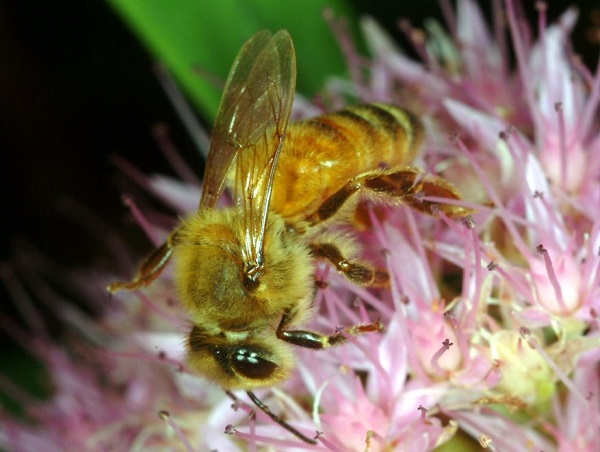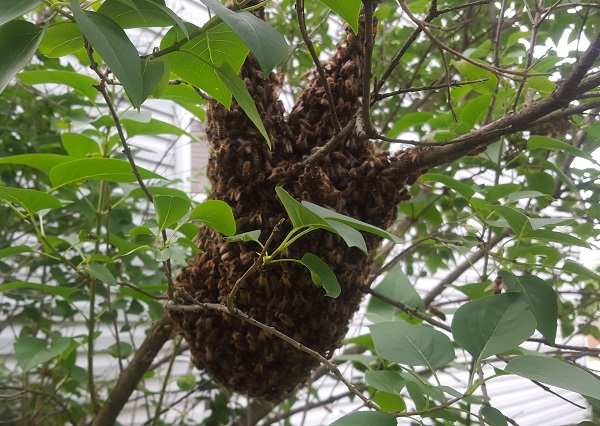Controlling Nuisance Honey Bees
ENTFACT-606: Controlling Nuisance Honey Bees | Download PDF
by Ric Bessin, Extension Specialist
University of Kentucky College of Agriculture
While we benefit from honey bees by their pollination and honey they collect, they can be serious pests at times. Bees that establish a hive in a home can be a problem because of increased hazard of humans being stung. Trash bins and recycling centers may also encourage robbing honey bees.
Honey bees typically search for flowers containing nectar and pollen for food. However, they are very opportunistic, and will seek syrups, sugar, fruit juices, and other sweet substances within easy access when flowers are not available.

Figure 1. Despite being so well known, honey bees are still misidentified frequently.
During the summer and fall when flowers are less numerous, robber honey bees and wasps can be very serious pests in places such as around trash containers and aluminum can recycling centers. Proper sanitation is the key to control of these problems.
Areas in which syrup or other sugars are frequently spilled or accumulate should be cleaned regularly to discourage honey bees. The use of plastic can liners and lids for trashcans will discourage honey bees. In areas such as aluminum can recycling centers where it may not be practical to keep these areas clean, barriers such as windows and door screens, or lids on bins should be installed. A few initial bees discovering a readily available sugar source can recruit a larger number in a short period of time.
In the fall, bees and wasps may be troublesome in orchards or gardens when feeding on damaged, dropped or overripe fruit. Fruit drops, bird‑damaged fruit and overripe fruit should be collected regularly and discarded.
Outdoor Swarms
Under certain conditions, a strong established honey bee colony will sub‑divide and one or more swarms will leave the hive. A swarm may cluster for a while on an exposed tree limb or bush near the old hive while scout bees search for a suitable permanent place to establish a new home.

Figure 2. Honey bee swarms are common from late April through June.
Some homeowners become concerned about these swarms of bees they find clustering on trees in their yards. Swarming bees usually are not aggressive and are not likely to sting unless disturbed. Bee swarms usually find a home within a day or so and the cluster will leave the tree limb on their own. Occasionally a small number of bees are left behind on the limb. They will not survive on their own and will die within a few days. Swarms of this type are often sought by beekeepers.
Bees in Buildings
Usually scout bees select a hollow tree, but many times the wall voids of homes or buildings are chosen for colony sites. The bees may nest in the wall or attic some distance from where they enter the wall. The nest is the comb on which the bees rest, rear brood and store honey.
Colonies of bees that establish themselves in attics or wall voids of homes near a home can be serious problems. After bees establish permanent homes, they can become very defensive and are much more likely to sting than are swarms. Salvaging colonies from wall voids may not be practical, but in some situations it may be possible. Concerns about Colony Collapse Disorder and the general decline in honey bee colony numbers have persuaded many homeowners to find ways to salvage honey bee colonies.
The homeowner may be able to find a list of local beekeepers willing to remove bees from structures through the local county extension office or even by contacting a local fire station. Be certain to establish an understanding with anyone removing bees regarding cleanup and repairs that may be needed post removal.
In situations where the colony cannot be removed by a beekeeper, exterminating procedures are recommended. It is always best to remove or destroy bees enhived too close to human activity.
Protection
Even if you are not sensitive to stings and are experienced in extermination work, it is wise to protect yourself. Distracting stings when exterminating bees in precarious positions may result in a fall from a ladder or roof. Minimum protection should include at least wearing a beekeeper's veil and leather gloves. It is also advisable to wear light colored coveralls with the sleeve and leg cuffs tucked in or closed with strong rubber bands. A bee smoker will help enormously to calm the bees and lessen their tendency to sting.
Control
Ficam dust is the only insecticide registered to exterminate bees from dwellings. If it is not applied correctly, persistent efforts may be needed to finally accomplish the job. Ficam dusted into the bee entrance may not reach the nest which can be some distance from the entrance. Foraging bees passing through the dusted area will be killed, but the queen and house bees (bees that stay home to take care of brood, etc.) may continue to live for some time. When house bees (young bees that remain in the hive) mature to take on field work chores, the colony may recover, unless the insecticide treatment is reapplied. Quicker and safer results will be received if the nest itself is treated.
The nest can be located sometimes by tapping the wall with a hammer and listening for an answering buzz from the bees. When the nest is located, a hole may be bored, preferably through the outside wall, so the insecticide can be applied onto the nest. Swarms are more easily killed soon after they enter the building. Established swarms are best killed in late winter when their numbers are low. The best time of the day to apply the insecticide is in late afternoon when all the bees are at home. The bees will be less cross on nice days than when the weather is over‑cast or rainy. Do not plug the hole immediately after dusting the nest because this may force agitated bees into the living quarters of the home.
Prevention
After the bees are killed, it is best to remove the nest if it can be done without causing extensive structural damage. Remove and discard the comb and honey. Do not salvage these materials if the colony was treated with insecticide. If the nest is not removed, the wax may melt or be riddled by wax moth larvae and begin to leak honey. If there is much honey it can seep through interior walls, leaving a permanent stain. Bees from other colonies can also be a nuisance around the home as long as honey remains to be robbed from the killed colony. Other scavenging insects, such as carpet beetles, are also attracted to killed bee colonies.
After a dead colony has been removed and the structural damage caused in removing the colony has been repaired, plug up all entrances through which other bee swarms can enter. Older homes which may have cracks in walls or under eaves are likely candidates for honeybee invasion. These holes should be plugged or screened prior to the time bees begin to swarm to prevent colony establishment. Odors left by the colony can linger for a long time and attract other swarming bees.
Revised: 11/19
CAUTION! Pesticide recommendations in this publication are registered for use in Kentucky, USA ONLY! The use of some products may not be legal in your state or country. Please check with your local county agent or regulatory official before using any pesticide mentioned in this publication.
Of course, ALWAYS READ AND FOLLOW LABEL DIRECTIONS FOR SAFE USE OF ANY PESTICIDE!
Photos: University of Kentucky Entomology.
